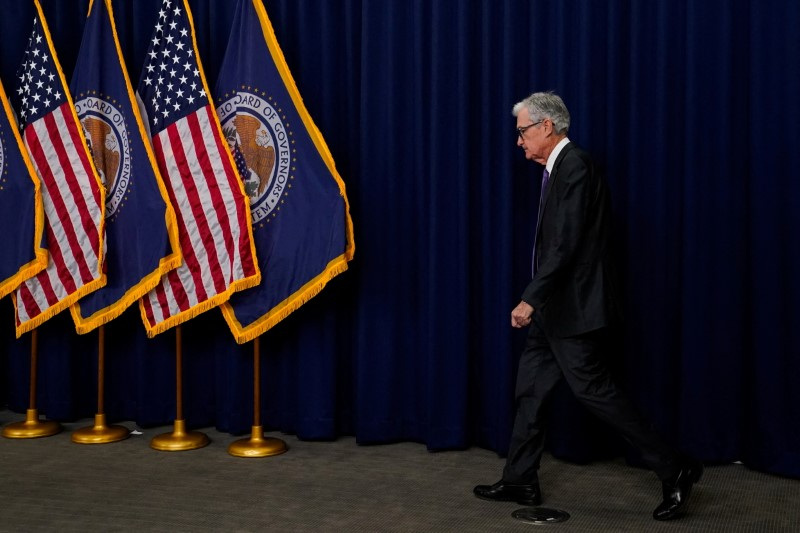Here’s your guide to the week ahead in financial markets from Ira Iosebashvili and Lewis Krauskopf in New York, Naomi Rovnick and Nina Chestney in London, and Kevin Buckland in Tokyo.
1/ JACKSON HOLE
Central bankers from around the globe gather in Jackson Hole, Wyoming, from Thursday for the Fed’s annual conference to chart the way forward for monetary policy. In focus this year are labour markets – a shift away from last year’s inflation theme.
U.S. Fed chief Jerome Powell gets a chance to fine-tune his message before September’s monetary policy meeting. Most market participants believe the Fed will begin cutting rates next month, after months of keeping them elevated to tamp down inflation.
How big the world’s foremost central bank will go, and how deeply it will eventually cut, remain open questions: a spate of recent alarming economic data – including unemployment numbers – pushed investors to ramp up bets on a 50 basis point cut in September.
2/ MIXED PICTURE
The outlook for global growth is another piece of the puzzle. Markets are febrile and struggling to assess the economic outlook as business activity softens but inflation stays above central banks’ target levels.
Purchasing managers’ indexes deliver a real-time snapshot of economic activity and – with most of them out on Thursday – will provide the next set of clues. July’s PMIs suggested an economic slowdown combined with persistent inflation, showing why central banks are in a bind.
U.S. manufacturing activity weakened and German numbers were surprisingly dour, indicating Europe’s economic powerhouse is contracting. But manufacturers’ input prices in advanced economies hit an 18-month high.
Inflation will dictate the pace and depth of future rate cuts. A repeat of July’s dour PMI trends might mean monetary easing happens more slowly than markets would like.
3/ IRATE OVER RATES
The Bank of Japan’s sudden pivot from uber-dove to ultra-hawk has put it in the firing line for lawmakers, after peppering its surprise rate hike at the end of July with hints of more to come.
One unexpected result was the steepest rout for Japanese stocks since 1987’s infamous Black Monday, amid a destabilizing spike in the yen against the dollar.
Politicians set to grill BOJ Governor Kazuo Ueda and his peers on Aug. 23 will do well to remember some of their most senior figures were leaning on the central bank to help reverse the yen’s exceptional weakness in the run-up to the move.
Recent macroeconomic indicators at least have been on the BOJ’s side, showing a stronger-than-expected rebound in growth amid a recovery for consumption.
A potentially bigger test comes the day of the special parliamentary session, with the release of the latest consumer price figures.
4/ DEMOCRATS ON DISPLAY
The U.S. presidential race heats up again with the Democrats aiming to generate fresh momentum for the candidacy of Vice President Kamala Harris at the party’s convention in Chicago.
Since her late entry into the race after President Joe Biden stepped aside, Harris has galvanized Democrats and erased the lead of Republican candidate Donald Trump in some opinion polls, edging ahead of Trump in some betting markets ahead of the Nov. 5 vote.
The four-day convention kicks off on Monday with a series of high-profile Democrats expected to give speeches geared toward rallying support for Harris.
The race is tight and investors are hoping to learn more about her policy positions.
Harris has been at pains to emphasize she would never interfere in Fed independence – a view that contrasts sharply with that of the Republican nominee and former president, who said presidents should have a say on Fed decisions.
5/ TENSIONS
A confluence of risk factors has pushed and pulled global energy markets in recent days, and there is little sense that will abate. Concern that conflict is spreading in the Middle East and threatening supply from the region has lifted international crude prices above $80 a barrel.
At the same time, worries about the strength of demand, particularly in China, are somewhat limiting oil’s gains.

European wholesale gas prices meanwhile have been volatile, with the spectre of Russian gas supply disruption on a transit route via Ukraine amplifying Middle East concerns.
Markets are concerned that heavy fighting near the Russian town of Sudzha, where Russian gas flows into Ukraine, could result in a sudden stop to transit flows via the war-torn nation before a five-year deal with Russia’s Gazprom (MCX:GAZP) expires.
(Graphics by Pasit Kongkunakornkul, Sumanta Sen, Vineet Sachdev; Compiled by Karin Strohecker; Editing by Jan Harvey)
To read the full article, Click Here

